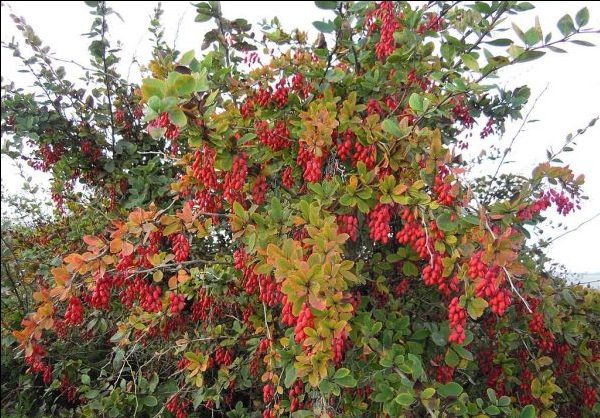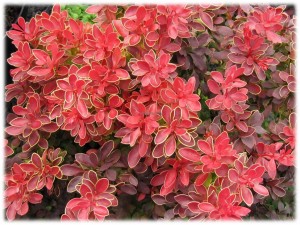But despite the unpretentiousness of all types of barberry, a recommended set of agrotechnical measures exists for them, as for all other plants. Compliance with them guarantees the manifestation of decorativeness and saturation with useful substances.
Barberry is considered a light-loving plant, but it also grows well in the shade. However, only a bush grown in the sun can boast of a very juicy and bright coloring of its leaves. On the leaves of barberry grown in the shade, green color will predominate, which will noticeably affect its decorative effect.
Barberry is not afraid of cold winters, it is undemanding to soil and moisture, but will not grow if waterlogged. When planting, holes should be made depending on the development of the root system, measuring 50-60 cm, at the same depth. The pit is filled with 5 kg. humus or peat, 200g. superphosphate, about.5 kg. wood ash. With such filling with fertilizers, the plants no longer require additional feeding for several years. Subsequently, it is enough to feed the barberry bushes once every 3 years with complex fertilizer.
For single plantings, the distance between the bushes is at least 1.5 m, and when planting a hedge, the bushes should be planted every 30 - 40 cm. Make sure that the root collar is not buried, otherwise the plants will not bear fruit for a long time.. The best time to plant barberry is late autumn. In winter, young bushes should be covered with 10 - 15 cm of earth. Adult bushes do not need shelter.
After planting, despite its undemanding requirements for water, barberry should be watered abundantly. After which the hole is mulched with humus.
How to care for barberry
Subsequent care for adult plants consists of pruning and protection from pests. In early spring, cut off all dried, broken branches growing inward. If the shoots have weak branches, they are cut low, into 3-4 buds. We must strive to ensure that the bush retains its natural shape, therefore, after its formation, heavy pruning is not recommended. The main purpose of pruning during this period is to obtain abundant flowering and fruiting.
Barberry lays flower buds on last year's shoots, which allows them to bloom early - in spring or early summer. Therefore, pruning of young shoots should be average (by 5 - 8 buds), then flowering next year will be abundant.
You should start pruning hedges the next year after planting. More than half of the above-ground part is cut off at once; such strong pruning will promote branching of the plantings.
The main method of propagating barberry is by seeds. Seedlings do not shy away from varietal and species characteristics, exactly repeating the mother plant. The seeds are collected when the berries are fully ripe and freshly sown in the garden beds in the fall. If you decide to postpone planting until spring, then the seeds will definitely have to be stratified. To do this, the seeds are mixed with wet sand and placed in the refrigerator for 2 - 3 months. Without stratification, when sowing in spring, barberry seeds will not germinate. Seedlings grow in the beds for two years, after which they are transplanted for growing, making sure to cut off the trunk heavily and lightly cut off the roots. If you already have a barberry bush growing on your site, it can easily be propagated by cuttings. However, given the abundance of barberry varieties, it is better to plant different types of this very decorative plant.
YOU CAN ALSO READ:
How to use barberry in garden design



 CUCUMBERS NEVER GET SICK, I'VE BEEN USING ONLY THIS FOR 40 YEARS! I SHARE A SECRET WITH YOU, CUCUMBERS ARE LIKE THE PICTURE!
CUCUMBERS NEVER GET SICK, I'VE BEEN USING ONLY THIS FOR 40 YEARS! I SHARE A SECRET WITH YOU, CUCUMBERS ARE LIKE THE PICTURE! You can dig a bucket of potatoes from each bush. Do you think these are fairy tales? Watch the video
You can dig a bucket of potatoes from each bush. Do you think these are fairy tales? Watch the video
 How our fellow gardeners work in Korea. There is a lot to learn and just fun to watch.
How our fellow gardeners work in Korea. There is a lot to learn and just fun to watch. Eye trainer. The author claims that with daily viewing, vision is restored. They don't charge money for views.
Eye trainer. The author claims that with daily viewing, vision is restored. They don't charge money for views. A 3-ingredient cake recipe in 30 minutes is better than Napoleon. Simple and very tasty.
A 3-ingredient cake recipe in 30 minutes is better than Napoleon. Simple and very tasty. Therapeutic exercises for cervical osteochondrosis. A complete set of exercises.
Therapeutic exercises for cervical osteochondrosis. A complete set of exercises. Which indoor plants match your zodiac sign?
Which indoor plants match your zodiac sign? What about them? Excursion to German dachas.
What about them? Excursion to German dachas.
A barberry hedge is certainly very beautiful. I say this with knowledge of the matter, I have such a fence. Its main advantage and at the same time disadvantage is that it is very prickly. No one can actually get through it, that's a virtue. But because of the thorns, such a hedge is very difficult to care for.By the time you cut it, you will be all torn. So think about whether to plant such a hedge or not.
To avoid injuring your hands when working with thorny bushes, you must use special thick gloves. But it’s really better not to let small children near the barberry bushes.
Fences are best made of iron, both beautiful and practical.
Barberry bushes look very neat if they are regularly pruned. Moreover, they also have berries - very healthy and tasty
Well, hedges also have a lot of advantages.